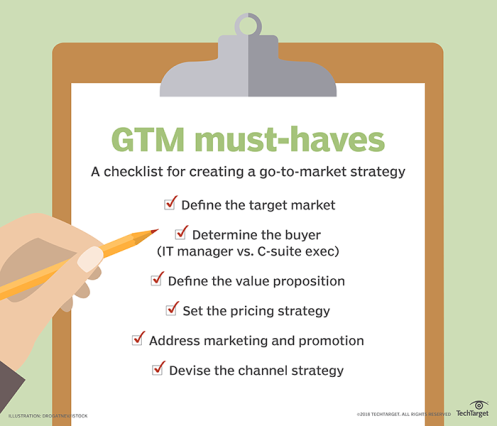What’s Your GTM Strategy? 7 Steps to Market Success

Photo by rawpixel.com on Pexels.com
Have you ever been told you need a Go-To-Market (GTM) Strategy for your company, whether it is a startup or your launching a new product at an established company?
We all kind of “get it” but when you actually try to create one it gets a little complicated. For instance, how is it different than a marketing strategy or a business plan?
What is a GTM Strategy?
GTM is often associated with new startups and product launches, especially those targeting channel partners. Indirect channels often become a part of a product vendor’s go-to-market plan. But GTM can also be used to describe the specific steps a company needs to take in order to guide customer interactions for established products.
A GTM strategy is an action plan that specifies how a company will reach target customers and achieve competitive advantage. The purpose of a GTM strategy is to provide a blueprint for delivering a product or service to the end customer, taking into account such factors as pricing and distribution.
A GTM strategy is somewhat similar to a business plan, although the latter is broader in scope and considers such factors as funding.
And it’s similar to a marketing strategy, although a marketing strategy focuses on how a company can reach an identified market over time and deliver against its overall value proposition.
The GTM Strategy is focused on how the organization will put offerings into the market to reach market penetration, revenue and profitability expectations. This charter is a superset of a marketing strategy as it impacts all functions within an organization with the goal of preparing the entire company for market success.
Your GTM strategy brings together all of the key elements that drive your business: sales, marketing, distribution, pricing, brand development, competitive analysis, and consumer insights.
It provides a strategic action plan that clarifies how to reach your target customers and better compete in your marketplace.
Another key point to stress is that the GTM strategy is not an event, i.e., a product launch. The GTM strategy is focused on the entire product lifecycle—from concept to grave.
A successful GTM strategy requires translating a product vision into messaging that will resonate with the target audience. This takes coordination between cross-functional teams — since messaging, training, and pricing all need to tie closely to the fixed timeline for launch.
Developing a GTM Strategy
Developing a strong GTM strategy is hard to get right – especially for any startup in high-growth mode. The right GTM requires bringing together all of the strategic assets that address your business and growth strategy: sales, marketing, product, channel, brand, and vision.
The benefits of developing this kind of strategy are huge, but a lot of pieces have to come together in order to properly prepare and ready your organization for investing in it.
What You Need to Know
Your customers are the lifeblood of your company, and they’re the only reason you can continue to exist. Every product you build, every marketing message you craft, should be based on your customers.
This is equally true for big companies and small companies.
How does your business connect with its customers? How do you deliver your unique value to your target customers? How do you go from the initial connection with a potential customer to the fulfillment of your brand promise?
The answer to these vital questions define your go-to-market strategy.
- Who is your buyer?
- Why would they buy a solution of any kind?
- Why would they buy from you?
- What is the solution to their problem that you specifically are providing?
You must know your customer. You must find a way to understand them.
- Who is your target customer?
- What is their targeted need?
- Does what you’re providing meet their specific need?
- What are the emotional pains and gains of your customer?
Remember no one buys a product, they buy a problem solved or a result achieved. If you fail to communicate what problem you solve or result you enable, what you build may be a moot point.
Before You Begin
GTM strategies, like any corporate strategy, is a matter of asking the right questions (and in the right order).
As a business leader, run through the following questions with your executive team:
- Where are you now? What is the current state of affairs in your business? Take inventory of your current business position and the current climate in your marketplace.
- Where do you want to go? What is the desired end picture of this new initiative? Define your ultimate vision.
- What has to happen to get you to your end picture? What strategic options are available to you? Determine the best solution paths to realizing your vision.
The main distinction between an overall corporate strategy and a GTM strategy is that the latter has a greater emphasis on connecting with your customers: sales, marketing, branding, distribution, customer touch points, and so on.
What’s Inside Your GTM Strategy?
The goal of a GTM strategy is to improve key business outcomes. This is mainly accomplished by aligning to the evolving needs of your customers.
To create an effective GTM strategy for your business, you want to create a detailed plan with the following six ingredients:
- Markets: What markets do you want to pursue?
- Customers: Who are you selling to? Who is your target customer?
- Channels: Where do your target customers buy? Where will you promote your products?
- Product (or Offering): What product/service are you selling? And what unique value do you offer to each target customer group?
- Price: How much will you charge for your products for each customer group?
- Positioning: What is your unique value or primary differentiation? How will you connect to what matters to your target customers and position your brand?
If you can concisely and effectively answer these six questions, you’ll be in the position to formulate a winning GTM strategy.

Seven Steps to Creating a GTM Strategy
Here are the seven vital steps to formulating your strategy:
Step 1: Define Your Target Markets
No product is appropriate for every market. Clarifying your ideal target markets is a vital element to formulating your GTM strategy. You can’t profitably pursue every market so you want to determine where you can most effectively differentiate your brand and attract the most profitable customers who resonate with your offering.
Step 2: Define Your Target Customer
Your goal is to understand who your customers are, how they behave, and what they experience. The better consumer insights you have, the better chances you have for executing an effective GTM strategy.
Step 3: Define Your Brand Positioning
Brand positioning is the process of positioning your brand in the mind of your customers.
Step 4: Define Your Offering
Now define your product or the product’s unique value proposition. Understanding your product’s key features and benefits is the first step. Then you must understand exactly how your product connects with your customers: the context of their use, the solutions it solves, the benefits they derive.
Step 5: Define Your Channels
Your goal isn’t just to identify your channels, but to ensure that each channel is as seamlessly integrated with each other as possible. Customers should have a consistent brand experience no matter what channel or touch point through which they interact with you.
Step 6: Build Your Budget Model
Once you’ve defined your channels, you’re ready to build a budget model. Here you’ll want to define your product pricing and estimate costs associated with your GTM strategy.
Step 7: Define Your Marketing Strategy
Now it’s time to put all of the pieces of this massive puzzle together. You’re going to want to develop a unique marketing strategy for each target market you’ve identified in step 1.
Your marketing mix will be determined by your strategy in each market. Starting with your brand positioning, your goal is to create competitive advantages for your product offering.
Biggest Mistakes when creating a GTM strategy
The biggest mistake I see startups making when they go to develop a GTM strategy is two-fold:
- Not having all strategic components articulated and strategically aligned
- Not allowing enough time to develop a strong GTM strategy that logically feeds into your growth and business strategy.
The Results of Doing the Work
Now let’s see how answering all of these helps clarify you build your business:
- What type of sales force or distribution model should you be building? Now you know whether it’s time to start looking into frictionless self-service models or developing a seasoned outbound team.
- Does your market have that many customers? Now you’ve got a go-to-market plan that can start sending off early warning signs if you’re not tracking towards desired customer growth.
- Does your value proposition justify the price points you need to hit? Now you can benchmark yourself against relevant competitors and focus your product team on creating a killer product for your price bracket.
- How much should you be spending on marketing vs sales? Now you know whether to put people in the field to chase after million-dollar deals, or invest more in inbound marketing, maybe with a freemium strategy, to grab those monthly subscriptions.
For help with the Challenges of Growing Your Business, contact me at mike@therevenuegroup.net.
Feel free to also visit our website to learn more about the services we offer to help you Position Your Potential: https://www.therevenuegroup.net/.
p.s.
I also invite you to download the white paper and learn the 5 step process on How to Quickly Increase Your Valuation: a Proven 5 Step Process.

Thank you so much for such a detailed article!
I thought it was interesting when you explained that it is important for businesses to understand how their customers behave so that they can develop a go-to-market strategy. I would think that it would be a good idea to work with a marketing and consulting company in a situation like. It seems like it would be helpful to work with a business that has experience with analyzing different markets and the people that use them.
Hi Mike,
You have described GTM strategy in this article wonderfully. Thanks for sharing these kind of useful content with us.